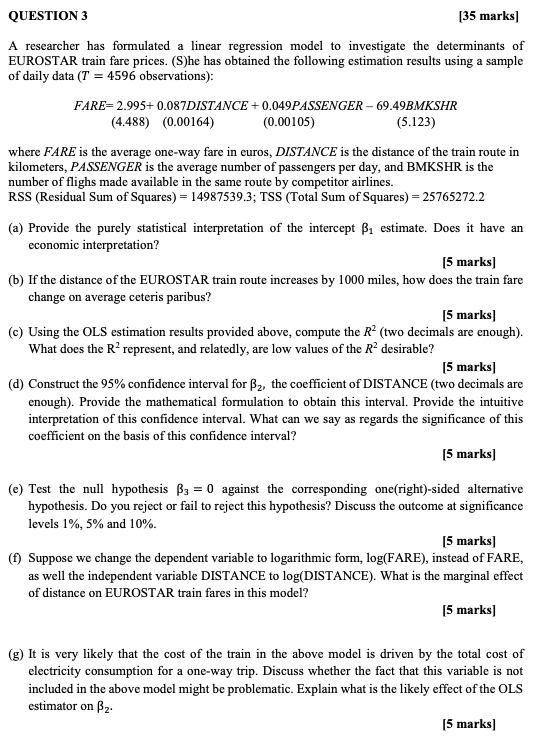QUESTION 3 [35 marks] A researcher has formulated a linear regression model to investigate the determinants of EUROSTAR train fare prices. (S)he has obtained the following estimation results using a sample of daily data (7 = 4596 observations): FARE= 2.995+ 0.087DISTANCE + 0.049PASSENGER - 69.49BMKSHR (4.488) (0.00164) (0.00105) (5.123) where FARE is the average one-way fare in euros, DISTANCE is the distance of the train route in kilometers, PASSENGER is the average number of passengers per day, and BMKSHR is the number of flight made available in the same route by competitor airlines. RSS (Residual Sum of Squares) = 14987539.3; TSS (Total Sum of Squares) = 25765272.2 (a) Provide the purely statistical interpretation of the intercept B, estimate. Does it have an economic interpretation? [5 marks] (b) If the distance of the EUROSTAR train route increases by 1000 miles, how does the train fare change on average ceteris paribus? [5 marks] (c) Using the OLS estimation results provided above, compute the R" (two decimals are enough). What does the R represent, and relatedly, are low values of the R" desirable? [5 marks] (d) Construct the 95% confidence interval for B2, the coefficient of DISTANCE (two decimals are enough). Provide the mathematical formulation to obtain this interval. Provide the intuitive interpretation of this confidence interval. What can we say as regards the significance of this coefficient on the basis of this confidence interval? [5 marks] (e) Test the null hypothesis By = 0 against the corresponding one(right)-sided alternative hypothesis. Do you reject or fail to reject this hypothesis? Discuss the outcome at significance levels 1%, 5% and 10%. [5 marks] (f) Suppose we change the dependent variable to logarithmic form, log(FARE), instead of FARE, as well the independent variable DISTANCE to log(DISTANCE). What is the marginal effect of distance on EUROSTAR train fares in this model? [5 marks] (g) It is very likely that the cost of the train in the above model is driven by the total cost of electricity consumption for a one-way trip. Discuss whether the fact that this variable is not included in the above model might be problematic. Explain what is the likely effect of the OLS estimator on B2- [5 marks]







